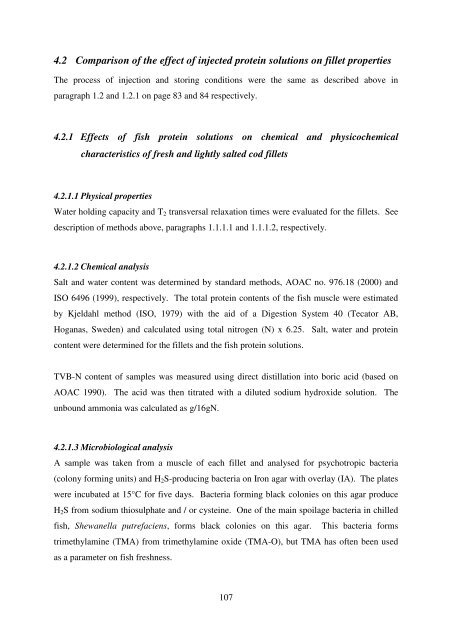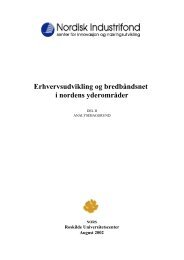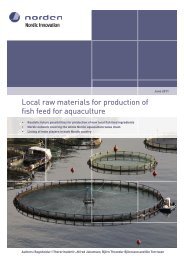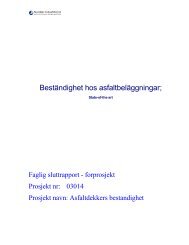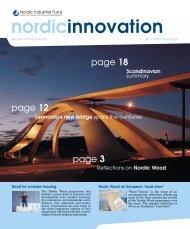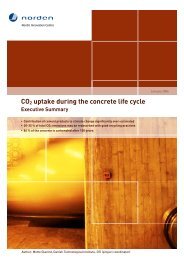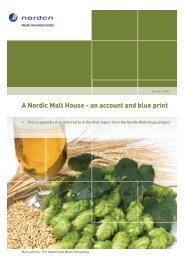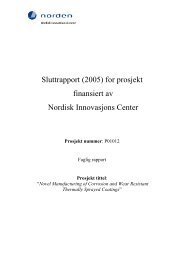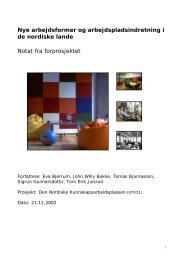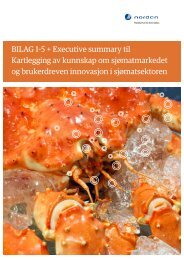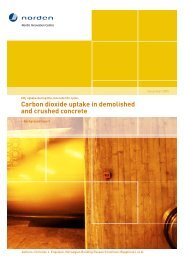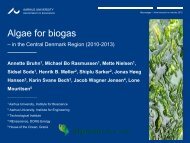Value added fish by-products - Nordic Innovation
Value added fish by-products - Nordic Innovation
Value added fish by-products - Nordic Innovation
You also want an ePaper? Increase the reach of your titles
YUMPU automatically turns print PDFs into web optimized ePapers that Google loves.
4.2 Comparison of the effect of injected protein solutions on fillet properties<br />
The process of injection and storing conditions were the same as described above in<br />
paragraph 1.2 and 1.2.1 on page 83 and 84 respectively.<br />
4.2.1 Effects of <strong>fish</strong> protein solutions on chemical and physicochemical<br />
characteristics of fresh and lightly salted cod fillets<br />
4.2.1.1 Physical properties<br />
Water holding capacity and T2 transversal relaxation times were evaluated for the fillets. See<br />
description of methods above, paragraphs 1.1.1.1 and 1.1.1.2, respectively.<br />
4.2.1.2 Chemical analysis<br />
Salt and water content was determined <strong>by</strong> standard methods, AOAC no. 976.18 (2000) and<br />
ISO 6496 (1999), respectively. The total protein contents of the <strong>fish</strong> muscle were estimated<br />
<strong>by</strong> Kjeldahl method (ISO, 1979) with the aid of a Digestion System 40 (Tecator AB,<br />
Hoganas, Sweden) and calculated using total nitrogen (N) x 6.25. Salt, water and protein<br />
content were determined for the fillets and the <strong>fish</strong> protein solutions.<br />
TVB-N content of samples was measured using direct distillation into boric acid (based on<br />
AOAC 1990). The acid was then titrated with a diluted sodium hydroxide solution. The<br />
unbound ammonia was calculated as g/16gN.<br />
4.2.1.3 Microbiological analysis<br />
A sample was taken from a muscle of each fillet and analysed for psychotropic bacteria<br />
(colony forming units) and H2S-producing bacteria on Iron agar with overlay (IA). The plates<br />
were incubated at 15°C for five days. Bacteria forming black colonies on this agar produce<br />
H2S from sodium thiosulphate and / or cysteine. One of the main spoilage bacteria in chilled<br />
<strong>fish</strong>, Shewanella putrefaciens, forms black colonies on this agar. This bacteria forms<br />
trimethylamine (TMA) from trimethylamine oxide (TMA-O), but TMA has often been used<br />
as a parameter on <strong>fish</strong> freshness.<br />
107


